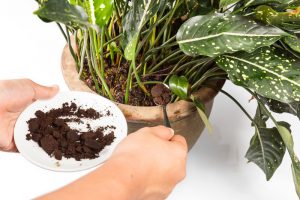How to Use Coffee Grounds in Your Garden: Benefits and Tips for Cincinnati Gardeners

How to Use Coffee Grounds in Your Garden: Benefits and Tips for Cincinnati Gardeners
Have you heard about using coffee grounds in your garden? Wake up your garden with coffee! Many people think coffee grounds are only for acid-loving plants, but they’re beneficial across the board. Here’s why adding coffee grounds to your garden can be a game-changer.
Why Recycle Coffee Grounds in the Garden?
Used coffee grounds are often discarded as waste at home, at work, or even at your local coffee shop. By adding coffee grounds to your garden, you’re not only enhancing soil quality but also reducing landfill waste. Plus, coffee grounds make your garden smell fantastic!
Benefits of Coffee Grounds for Your Garden
- Improves Soil Quality: Coffee grounds are an excellent source of organic matter, improving soil structure, moisture retention, and fertility for both garden beds and containers.
- Natural Fertilizer: They provide a gentle dose of nitrogen along with small amounts of phosphorus, potassium, and other trace minerals like calcium and magnesium, which help boost plant growth.
- Speeds Up Composting: Combined with brown materials like leaves or straw, coffee grounds generate heat that accelerates composting—perfect for your compost pile!
- Adjusts Soil pH: While coffee grounds are not as acidic as fresh coffee, they may still help slightly lower soil pH over time, averaging around 6.2. Regular soil testing ensures optimal pH levels.
- Suppresses Fungal Issues: Coffee grounds appear to help reduce common fungal rots and wilts, promoting healthier plants.
- Attracts Earthworms: Worms love coffee grounds, which enhance soil aeration and nutrient cycling.
Ways to Use Coffee Grounds in the Garden
1. Soil Amendment
- Sprinkle used grounds directly into your flower and vegetable beds, then lightly till them into the soil. A general guideline is up to 6 pounds per 100 sq. ft.
2. Fertilizer for Acid-Loving Plants
- While coffee grounds are versatile, acid-loving plants like azaleas, hydrangeas, and evergreens particularly enjoy them. Sprinkle grounds around the base of these plants and water them in.
3. Rose Care
- Rose growers have long used coffee grounds to promote strong growth and vibrant blooms. Add grounds around the base of your roses as part of your feeding routine.
4. Compost Booster
- Coffee grounds are perfect for the compost bin! Layer them with brown materials (like leaves or straw) to balance the carbon-to-nitrogen ratio and speed up decomposition.
5. Natural Pest Deterrent
- Grounds are reported to deter certain pests, including slugs and ants. Some gardeners even use coffee grounds to keep cats out of mulch beds.
6. Lawn and Indoor Plants
- Sprinkle coffee grounds into mulch or on the lawn, then water them in. They’re also great for indoor plants; sprinkle a thin layer on top of the soil or mix them with potting soil during repotting.
Free Coffee Grounds: Take Advantage!
Even if you don’t drink coffee, many coffee shops offer used grounds for free. Don’t miss out on this eco-friendly resource—your soil, plants, and earthworms will thank you!
Have Gardening Questions? Ask the Experts!
For more tips on using coffee grounds in your garden or other gardening questions, reach out to our horticultural experts at Natorp’s. Check out our Plant Care Library for more resources and ideas to make gardening simple.